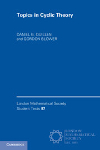- About MAA
- Membership
- MAA Publications
- Periodicals
- Blogs
- MAA Book Series
- MAA Press (an imprint of the AMS)
- MAA Notes
- MAA Reviews
- Mathematical Communication
- Information for Libraries
- Author Resources
- Advertise with MAA
- Meetings
- Competitions
- Programs
- Communities
- MAA Sections
- SIGMAA
- MAA Connect
- Students
- MAA Awards
- Awards Booklets
- Writing Awards
- Teaching Awards
- Service Awards
- Research Awards
- Lecture Awards
- Putnam Competition Individual and Team Winners
- D. E. Shaw Group AMC 8 Awards & Certificates
- Maryam Mirzakhani AMC 10 A Awards & Certificates
- Two Sigma AMC 10 B Awards & Certificates
- Jane Street AMC 12 A Awards & Certificates
- Akamai AMC 12 B Awards & Certificates
- High School Teachers
- News
You are here
Topics in Cyclic Theory

Publisher:
Cambridge University Press
Publication Date:
2020
Number of Pages:
328
Format:
Paperback
Price:
41.99
ISBN:
978-1108790444
Category:
Monograph
[Reviewed by , on ]
John McCleary
05/2/2024
Rings are ubiquitous in mathematics. There are the familiar rings of polynomials in any finite number of variables, rings of square matrices with entries in a field, and the noncommutative group rings \( kG \) for a group \( G \) and a field \( k \). The rings of interest in this book are algebras, that is, they are rings that are also vector spaces over a field for which multiplication by a scalar passes through the product (\( u(ab) = (ua)b = a(ub) \) for \( a \) and \( b \) in the algebra, \( u \) in the field). Important examples include the set of Fredholm operators on a Hilbert space, \( C^{*} \)-algebras, and the algebra \( C^{\infty}(M,K) \) of smooth real or complex valued functions on a manifold.
In the case of a commutative \( C^{*} \)-algebra \( A \) there is a space \( X \) and an isomorphism between \( A \) and the algebra of complex-valued functions on \( X \). In this case, \( X \) is the collection of maximal ideals in \( A \) which is a compact topological space. This is the theorem of Gelfand and Naimark. When \( A \) is a noncommutative algebra, there is an analogue of the de Rham theory of the commutative algebra \( C^{\infty}(M; \mathbb{R} ) \) in which differential forms live for which there is a pairing with another algebraic invariant of \( A \), its algebraic \( K \)-theory. This analogue is the cyclic cohomology of \( A \) and the main topic of the book.
In various lecture courses given at Oxford University, Quillen introduces and develops cyclic cohomology and its many applications. His presentation emphasizes analysis and differential geometry – a companion volume Topology and K-Theory: Lectures by Daniel Quillen edited by Robert Penner focuses on topology and homological algebra. The editor of this volume, Gordon Blower, has brought together several courses given by Quillen: Chapters 3 and 4 treat functional analysis and operator algebras; Chapters 6 and 7 focus
on topics found in joint work of Cuntz and Quillen especially on Karoubi operators; the remaining chapters 1, 2, 5, and 8 through 12 treat cyclic cohomology and can be read as an introduction to the subject. The algebraic framework of differential geometry plays a key role in Quillen’s presentation. In particular, connections and curvature motivate many constructions.
These lectures reveal the breadth of Quillen’s interests and the depth of the ideas developed. The lectures are clear and careful, rich in detail. The book is an opportunity to be lectured anew by this extraordinary mathematician.
John McCleary is Professor Emeritus of Mathematics and Statistics at Vassar College.
John McCleary is Professor Emeritus of Mathematics and Statistics at Vassar College.
See the publisher's website.
- Log in to post comments




